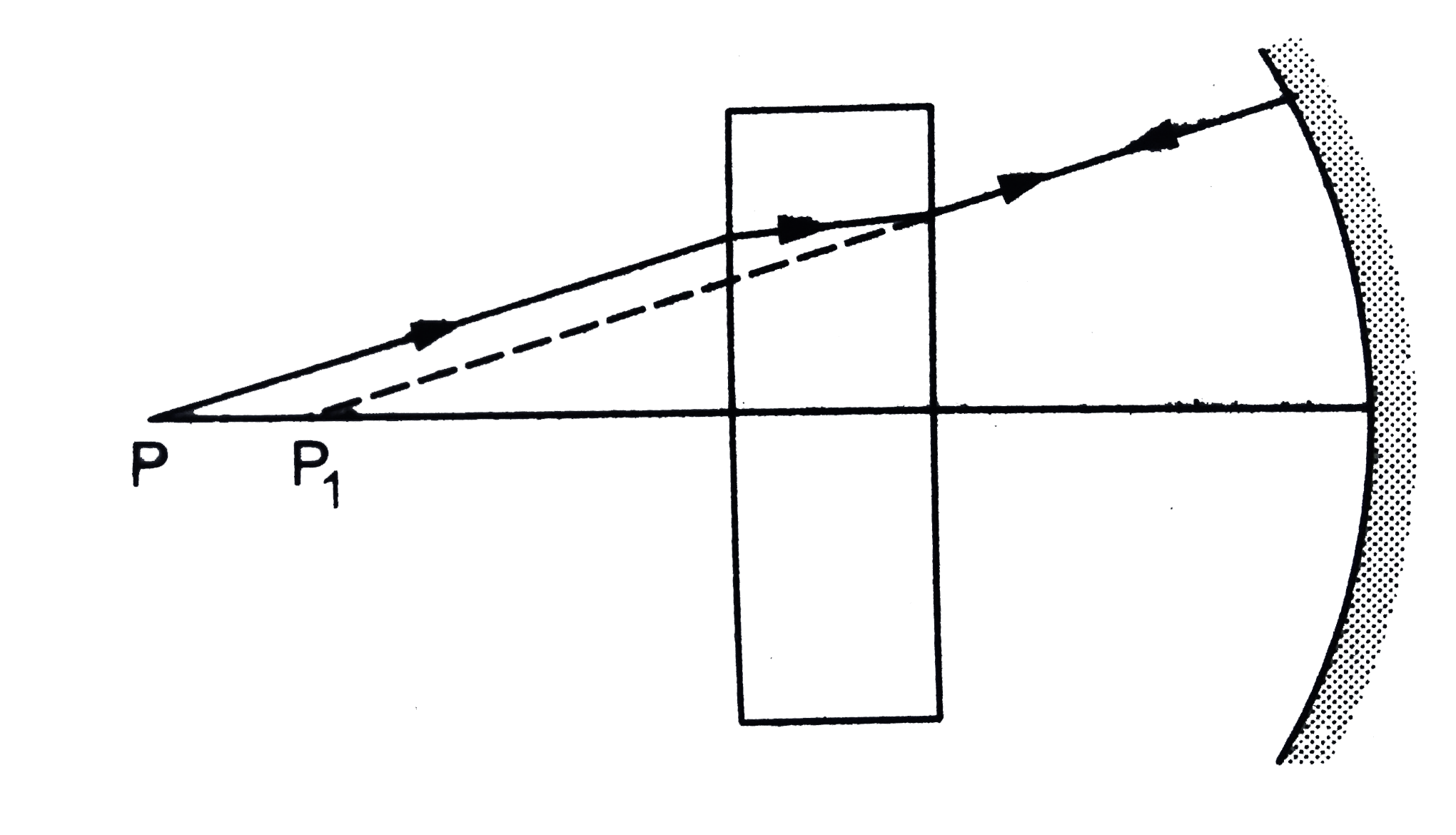A microscope is focused on a mark on a piece of paper and then a slab of glass of thickness 3cm and refractive index 1.5 is placed over the mark. How should the microscope be moved to get the mark in focus again ?
4.5cm downward
1cm downward
2cm downward
1cm upward
The correct Answer is:D
To solve the problem of how to adjust the microscope after placing a glass slab over the mark, we can follow these steps:
Step 1: Understand the Concept of Apparent Shift
When a glass slab is placed over an object, the light rays from the object will refract as they pass through the slab. This causes the object to appear to be at a different position than it actually is. The apparent shift can be calculated using the formula:
Shift=T(1−1μ)
where:
- T is the thickness of the glass slab,
- μ is the refractive index of the glass.
Step 2: Identify the Given Values
From the problem, we have:
- Thickness of the glass slab, T=3cm
- Refractive index of the glass, μ=1.5
Step 3: Substitute the Values into the Formula
Now, we can substitute the values into the formula to find the shift:
Shift=3(1−11.5)
Step 4: Calculate the Value Inside the Parenthesis
First, calculate 11.5:
11.5=23≈0.6667
Now, calculate 1−11.5:
1−0.6667=0.3333
Step 5: Calculate the Shift
Now, multiply this result by the thickness T:
Shift=3×0.3333=1cm
Step 6: Determine the Direction of Movement
Since the mark appears to be higher due to the refraction, the microscope must be moved upward by the calculated shift to bring the mark back into focus.
Final Answer
The microscope should be moved 1 cm upward to get the mark in focus again.
---
When a glass slab is placed over an object, the light rays from the object will refract as they pass through the slab. This causes the object to appear to be at a different position than it actually is. The apparent shift can be calculated using the formula:
- T is the thickness of the glass slab,
- μ is the refractive index of the glass.
From the problem, we have:
- Thickness of the glass slab, T=3cm
- Refractive index of the glass, μ=1.5
Now, we can substitute the values into the formula to find the shift:
First, calculate 11.5:
Now, multiply this result by the thickness T:
Since the mark appears to be higher due to the refraction, the microscope must be moved upward by the calculated shift to bring the mark back into focus.
The microscope should be moved 1 cm upward to get the mark in focus again.
Topper's Solved these Questions
- RAY OPTICS AND OPTICAL INSTRUMENTSBOOK - NCERT FINGERTPS ENGLISHCHAPTER - RAY OPTICS AND OPTICAL INSTRUMENTSEXERCISE - Reflection Of Light By Spherical Mirrors
5 Videos
- RAY OPTICS AND OPTICAL INSTRUMENTSBOOK - NCERT FINGERTPS ENGLISHCHAPTER - RAY OPTICS AND OPTICAL INSTRUMENTSEXERCISE - ASSERTION AND REASON
15 Videos
- PRACTICE PAPPERBOOK - NCERT FINGERTPS ENGLISHCHAPTER - PRACTICE PAPPEREXERCISE - Practice Paper 3
50 Videos
- SEMICONDUCTOR ELECTRONICS : MATERIALS , DEVICES AND SIMPLE CIRCUITS BOOK - NCERT FINGERTPS ENGLISHCHAPTER - SEMICONDUCTOR ELECTRONICS : MATERIALS , DEVICES AND SIMPLE CIRCUITS EXERCISE - Assertion And Reason
15 Videos
Similar Questions
A small ink dot on a paper is viewed through a glass slab of thickness 10cm and refractive index 1.5. By what distance would the dot appear to be raised?
View SolutionAn object is placed 21 cm in fron of a concave mirror of radius of curvature 20 cm.A glass slab of thicknes 3 cm and refractive index 1.5 is palced close to the mirror in the space between the object and the mirror. Find the position of the final image fromed. The distance of the nearer surface of the slab from the mirror is 10 cm.

View SolutionAssertion A diverging lens (in air) cannot be made more diverging whatever be the medium we choose completely immerse the lens.
Reason The minimum refractive index of any medium is 1.
View SolutionA microscope is focussed on a point object, and then its objective is raised through a height of 2cm when a glass slab of refractive index 1.5 is placed over this point object such that it is focussed again. The thickness of the glass slab is
View SolutionAn object is placed 21 cm in front of a concave mirror of radius of curvature 10cm. A glass slabe of thickness 3cm and refractive index 1.5 is then placed close to the irror in the space between the object and the mirror. The distance of the near surface of the slabe from the mirror is 1cm. The final image from the mirror will be formed at
View SolutionA point object is placed at the center of a glass sphere of radius 6cm and refractive index 1.5. The distance of virtual image from the surface is
View SolutionAn object P is focussed by a microscope M. A glass slab of thickness 2'1 cm is introduced between P and M. If the refractive index of the slab is P5, by what distance should the microscope be shifted to focus the object again ?
View SolutionA glass slab of thickness 3cm and refractive index 1.5 is placed in front of a concave mirror of focal length 20cm. Where should a point object be placed if it is to image on to itself?
View SolutionA travelling microscope is focussed on to a scratch on the bottom of a beaker. Water of refractive index 43 is poured in it. Then the microscope is to be lifted through 2 cm focus it again. Find the depth of water in the beaker.
View SolutionA point object is placed at a diatance of 25 cm from a convex lens of focal length 20 cm. If a glass slab of thickness t and refractive index 1.5 is inserted between the lens and the object, the image is formed at infinity. The thickness t is
View Solution
